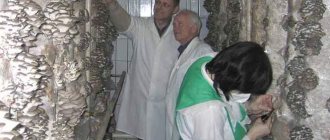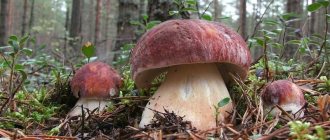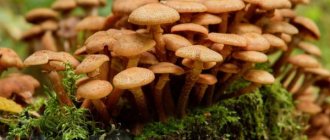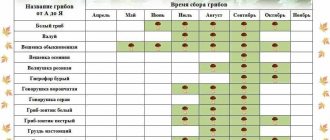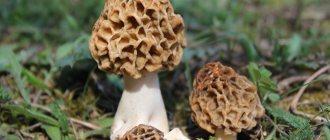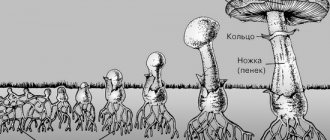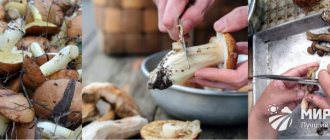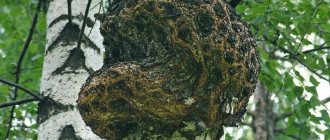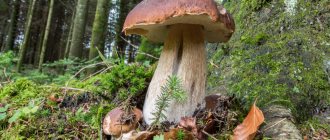Mushrooms
2
1962
Article rating
Kira Stoletova
Edible forest mushrooms are a storehouse of useful vitamins and nutrients that can completely replace a meat product. For their high nutritional value, it is not for nothing that they are called “vegetable” or “forest” meat. They are healthy, tasty, nutritious and, most importantly for mushroom pickers, they grow quickly. Active reproduction and growth of mushrooms, starting from the first spring collection season and ending with the last, autumn, is due to their unique biological characteristics.
Features of mushroom growth in the forest
How does porcini mushroom grow?
In autumn, white mushroom can be found throughout Russia. Although the mycelium of this representative of the mushroom family functions from the beginning of spring until cold autumn, the main period for harvesting the mushroom harvest occurs in warm September and the first half of October. Chunky porcini mushrooms can be found both in cozy deciduous and cool mixed forests. Moreover, representatives of this fungal genus prefer old, mature trees, more than half a century old. Strong, elastic mushrooms are often hidden under powerful roots or under a layer of moss.
The first wave of boletus mushrooms is expected by mushroom pickers in June, and then in late July - early August. However, during hot summers, the period of mushroom hunting is no more than a few days. Much more productive time occurs in the first half of autumn. It is at this time that the so-called “greenhouse effect” occurs on the earth - the soil, calcined over the summer, generously gives up its heat with the difference in night and day temperatures.
Beneficial features
Porcini mushrooms contain more riboflavin than others, a substance responsible for the growth of nails, hair, and skin health.
Speaking about the beneficial properties of the mushroom, it is necessary to emphasize that mushrooms absorb substances from the environment in which they grow. This is what is most often forgotten when collecting. Therefore, you should not collect them near roads, factories, industrial zones and landfills.
The main task facing a competent mushroom picker is to find white specimens that grow in the distant forest, and at the same time collect and prepare them correctly. The taste of mushroom dishes and their benefits depend on proper collection and preparation.
The most useful element contained in them is riboflavin. Real mushroom pickers know that regular consumption of riboflavin will quickly relieve pathologies associated with the thyroid gland.
Riboflavin, also known as lactoflavin or vitamin B2, is vital literally every day for any person.
There are many artificial vitamins and nutritional supplements that contain this component. But why consume artificially synthesized substances if a lot of riboflavin is found in tasty and familiar white representatives of the mushroom kingdom?
Conditions for growth
The boletus mycelium grows 10–15 cm deep into the soil and is very demanding of moisture. Therefore, even with slight dehydration of the soil, the mycelium dries out and stops bearing fruit. In addition, whites are very picky about air humidity - it must be at least 60%. Mushrooms stop growing even in moist soil provided there is atmospheric dryness.
That is why representatives of this genus most often prefer to grow under the cover of mosses and lichens, which provide them with the necessary microclimate. The porcini mushroom grows quickly at an air temperature of +18...+28°C. And the favorite period of boletus, when they grow as large as possible in a short time, is warm and rainy autumn weather.
Features of growth and development of mushrooms
Most mushrooms grow within two weeks
. In this short period of time, the mushroom manages to reach standard sizes, but often growth stops already on the fifth day. Interestingly, the diameter of the fruiting body continues to increase even after upward growth has stopped. Looking at the mushroom, you can decide that its cap takes the longest to grow, and this is true.
Its development most actively occurs after the end of the growth period of the leg; the diameter increases due to growth along the periphery. This is due to the fact that the stem itself is the connecting component between the cap and the main mass of the mycelium. But at the same time, the stalk itself is a structural component of the mycelium. The thinnest strands of micelles rise above the surface, merge and form something similar to a fruiting body.
And after a week we can see a classic mushroom, which, after a detailed examination, must be sent to the basket.
Careful inspection
– this is a strictly necessary measure, because even edible mushrooms can cause poisoning. Poisonous mushrooms are dangerous due to toxins, but edible ones can grow next to busy sections of highways, collecting all the elements of the periodic table. And measures to trim the fruiting body will not help, because heavy metals settle in the soil.
It is from this soil that the mycelium micelle receives nutrients, develops and gives rise to new fruiting bodies. So don’t be lazy to go some distance from any roads
, on the permanent paths of mushroom pickers.
Another feature of mushrooms is that they are practically not processed in our intestines, like fiber. Thanks to this, mushrooms are able to improve motility and normalize the functioning of the gastrointestinal tract.
Where do they grow?
Sturdy whites grow under old oaks, birches and conifers, and are also very fond of lichens. Depending on where they grow, these mushrooms acquire different colors. Thus, under oak trees you can find boletus with a brown-gray cap and loose flesh.
Near the pines there is a forest dweller with a dark cap and brownish flesh on a thick short stalk, and under the birches grow very light mushrooms, the cap of which reaches a diameter of 15 cm. One of the most common representatives of this species is found under spruce trees - its stalk is taller than that of brothers, and the cap has a reddish-chestnut tint.
Inexperienced mushroom pickers often mistakenly mistake the gall mushroom for boletus, which is very similar to the white one in appearance. The main difference between gall fungus is the darkening of the pulp at the cut site and a bitter taste.
How long does it take for mushrooms to grow after cutting? How fast does a mushroom grow?
There are many diametrically opposed opinions regarding the growth of mushrooms. Some firmly believe that the white mushroom grows in a day, others that it grows in a week, and still others have no idea at all in this regard. Strangely enough, neither in our nor in foreign literature have we found clear information about the growth of white fruiting bodies. But my friend and I did not calm down and tried to solve this riddle. In August 1987, we examined the aboveground growth of fruiting bodies of white spruce boletus and common boletus in their natural habitat. Regularly every day at the same hour and from the same point we photographed mushrooms. By the way, we consider our greatest achievement to be the fact that we managed to protect our experimental subjects from the attacks of other mushroom pickers.
White mushroom at the time of discovery
White mushroom after 24 hours
White mushroom after 48 hours
White mushroom after 72 hours
The photographs show the average size and shape of fruiting bodies on individual days of their life. This proves the incorrectness of the statement that the fruiting body grows in one day, and in addition refutes the widespread superstition that the mushroom stops growing as soon as someone looks at it, because we looked at it often and for a long time.
We also established that at first the fruiting bodies grow generally evenly in all their parts. Approximately in the middle of development, the leg suddenly stops growing in thickness, but quickly lengthens; this process ends in the last quarter of the life of the fruiting body. The second half of the development of the fruiting body is characterized by rapid growth of the cap, accompanied by intensive spore formation. Finally, the growth of the fruiting bodies suddenly stops, and they begin - depending on the specific situation - to die quickly or slowly. For our white one, this happened after thirteen, and for the boletus - after nine days of above-ground growth.
We took into account the weather, the amount of precipitation and above all the temperature, which fluctuated quite significantly. However, these factors had no effect on growth. Obviously, once the fruiting body begins to grow and unless a catastrophe occurs, then nothing can stop it.
The white one we studied had a “programmed” mass of 0.3 kg. Now imagine the daily growth of the fruiting body with a planned weight of 2.5 kg! In this case, you can easily believe that the mushroom grows in one day. True, although he will grow, he will not mature.
If it were not for curiosity, it would never have occurred to us to make such an observation. Are you also curious? There is nothing stopping you from conducting a similar experiment. Vacation is the best time for this.
How will they grow
Experienced fans of mushroom hunting note that 15–20 days after warm downpours, white specimens can be found in the forest, the cap diameter of which reaches 20–25 cm. It is worth noting that the lifespan of white mushrooms is not as long as is commonly believed - these mushrooms are at peak maturity reach 12–14 days after the start of growth.
Upon reaching 10–12 days, the mushroom stem stops growing, while the cap continues to increase in diameter for another 2–3 days. After this, the process of decay begins in the pulp, and it loses its good nutritional properties.
The best time to collect young porcini mushrooms, which are perfect for pickling and pickling, is 4–5 days after a good rain. In addition, such mushrooms have not yet been attacked by parasites, which are very fond of dense, aromatic pulp.
Video: How porcini mushrooms grow
Per night
There is an opinion that boletus can grow literally overnight. However, in fact, the porcini mushroom is not so fast - its growth rate entirely depends on the surrounding humidity and air temperature both at night and during the day. Representatives of this mushroom family are more demanding of environmental conditions than its relatives, for example honey mushrooms or boletus. At +10°C, the white cap grows in diameter by about 1–1.5 cm overnight.
Did you know? In 1961, a giant boletus was found on the territory of the USSR, whose weight exceeded 10 kg, and the diameter of the hat was 58 cm.
Per day
In a day, the boletus can grow by 2–3 cm and, already a couple of days after a warm downpour, there is a chance to stumble upon a clearing of young and strong white ones. Boletus mushrooms can settle on it either singly or in entire families. Experienced mushroom pickers who devote a lot of time to collecting whites know hidden places and often notice an interesting fact: walking through favorite mushroom places, you can collect a good harvest of whites even where yesterday there was no hint of mushrooms hiding under the leaves.
During the week
If the weather is favorable, then you shouldn’t spend a long time going for a mushroom harvest. In a week, under favorable conditions, boletus mushrooms can grow to truly impressive sizes. If we talk about how much such a mushroom weighs, then the average weekly boletus reaches a weight of 150–200 grams. There are often larger representatives. The diameter of the cap of such specimens can reach 20–25 cm.
Find out also how to make delicious creamy porcini mushroom soup.
How long do they grow after rain?
A small boletus emerges to the surface of the soil literally in the first hours after a warm downpour. Its weight is tiny, about 2 grams. However, with the right amount of moisture in the environment, maintained night and day throughout the entire period of growing the mushroom, there is a real chance of finding a white one, the weight of which reaches 300–400 grams. After all, it’s not for nothing that there is a common expression: “They grew up like mushrooms after the rain.”
At high temperatures
Like many of its relatives, boletus mushrooms do not like heat. If the air temperature exceeds +28°C and the humidity drops below 60%, the plant body dries out. This is due to the inability of the fungal body to delay the process of evaporation of moisture from the surface of the plant. In addition, in the heat, the boletus mycelium also becomes dehydrated, which has a depressing effect on the entire boletus harvest.
Important! A cut porcini mushroom loses its beneficial properties without treatment 10 hours after collection.
When it's cold
The boletus also stops growing with the arrival of cold days, when the average daily temperature drops below +10°C. Low temperature disrupts the chemical processes in the mycelium and body of the boletus, which causes the growth of whites to stop. Therefore, with the onset of the first autumn frosts, it is better to look for porcini mushrooms under the roots of old trees and in secluded places surrounded by fallen leaves. There, for some time after the onset of cold weather, a microclimate remains suitable for the full growth of boletus mushrooms.
At what speed do milk mushrooms grow? How long does boletus grow after rain?
The mycelium of the boletus is located almost on the surface, i.e. under the top layer of soil - at a depth of 10-15 cm. Therefore, good rain and warm sunny weather are needed. Only under such conditions will the mycelium grow.
Oilseeds are collected in young coniferous forests, as well as in open, well-lit clearings. They grow in large families, which allows you to collect a whole basket in one place. An important role for mushroom picking is played by how much boletus grows after rain.
It is worth noting that boletus on a good mycelium after rain begins to grow the very next day. If a mushroom picker wants to collect strong young boletus, then you should go “hunting” after 12-18 hours.
How long it takes boletus to grow after rain depends on the condition of the soil, lighting, air temperature, etc. On average, 2-3 days are enough to reach full maturity of the mushroom. But do not forget that boletus mushrooms are “fast” mushrooms, which means they will also begin to spoil quickly. The most important thing here is to correctly calculate the moment of going into the forest.
Every mushroom picker knows that the main harvest of boletus occurs in August, September and early October. Therefore, how long boletus mushrooms take to grow depends on two main factors. The first, as already mentioned, is well-moistened soil, and the second is a warm and sufficiently illuminated upper layer of the mycelium.
Many knowledgeable mushroom pickers claim that it takes very little time for an oil can to rise from the ground. So, how long does the butterfly mushroom grow after warm rain? 5-7 hours are enough, and a young, clean, small mushroom appears in the basket. By the way, it is precisely these butters that are highly valued for marinating in jars because they have a beautiful appearance and the appropriate size.
As you can see, in order to correctly determine how much an oil can grows, it is necessary to take into account weather conditions and the characteristics of the local climate. They must be suitable, because even after heavy rainfall, boletus may not appear. Sometimes it happens that there is a lot of moisture, but there is no sunlight and heat. Or the soil is poorly saturated with moisture, and the sun greatly heats the air and the mycelium dries out.
Collection time
The best time for harvesting mushrooms is considered to be warm September and the first half of October. On fine autumn days, in just a few hours of walking in the forest you can collect baskets full of whites. Especially if you know about the favorite habitats of boletus mushrooms. The fertile mushroom time usually lasts until regular morning frosts, and even then in the forest you can find strong, slightly frozen boletuses growing under moss and leaves, along with other mushrooms - redheads, boletus and honey mushrooms.
How to collect correctly
Anyone who has ever gone to the forest to pick mushrooms knows the basic rules for picking:
- The mushroom trophy cannot be pulled out of the ground along with the roots.
- When going out on a “quiet hunt,” you should stock up on a small, sharp knife, with which you cut off the prey above the soil surface. Thus, the mycelium is preserved and grows, and next year you can count on a generous harvest of whites in the same place.
- Before going into the forest, you should stock up on a long stick or staff to carefully dig out mounds of leaves, moss and earth, under which strong families are hiding.
Autumn is a great time to visit a quiet, colorful forest, filled with the smell of mushrooms and fallen leaves. And what could be better than a basket of strong boletus, brought from a walk and filling everything around with a mushroom aroma.
What is a mushroom?
It is necessary to understand what we are talking about. Mushrooms belong to a separate kingdom, due to the presence of a number of specific characteristics. What we used to call a mushroom is actually a fruiting body that grows from the mycelium of the mycelium.
So that you understand, underground, for many meters, there is a branched mycelium, which is the underground part of the mushroom. It grows regularly and “gains strength,” but only at a certain period begins to bear fruit.
By the way, the process of their destruction begins within a day after the end of intensive growth
. So it’s important not to miscalculate the moment of going into the forest.
